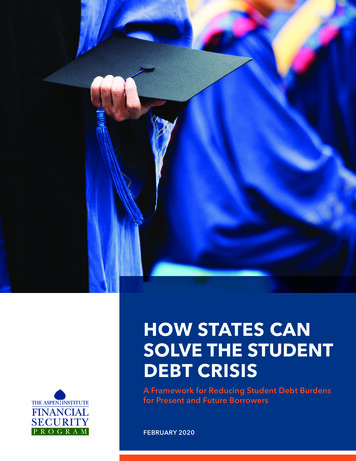
Transcription
HOW STATES CANSOLVE THE STUDENTDEBT CRISISA Framework for Reducing Student Debt Burdensfor Present and Future BorrowersFEBRUARY 2020
AUTHORSKiese Hansen and Tim Shaw authored this report, with research and writing assistance from Jordan Thomas.ACKNOWLEDGMENTSAspen FSP would like to thank Kiese Hansen and Tim Shaw for authoring this report; Jordan Thomas and forresearch and writing assistance; Raquan Wedderburn for data analysis; Karen Andres, Katherine Lucas McKay,Joanna Smith-Ramani, and Elizabeth Vivirito for revisions and insights; Ben Barrett, Don Baylor, Jinann Bitar,Velvet Bryant, David Croom, Jessica Dorrance, Portia Polk, Jack Porter, and Sarah Sattelmeyer for their advice andfeedback. We would also like to thank the following interviewees: Whitney Barkley-Denney, Julie Benkoske, GaryBrahm, Michael Best, Ian Bridgeforth, Nia Davis, Yasmin Farahi, Seth Frotman, Tiffany Jones, Christina Long, JulioMartinez, Dawn Medley, Kathleen Smith, Bridget Tate, and Ashley Williams. Finally, Aspen FSP would like to thankthe Annie E. Casey Foundation for their generous support. The findings, interpretations, and conclusions expressedin this report—as well as any errors—are Aspen FSP’s alone and do not necessarily represent the view of Aspen FSP’sfunders or those acknowledged above.The Aspen Institute Financial Security Program thanks the Annie E. Casey Foundation for their generous support.How States Can Solve the Student Debt Crisis is part of the Aspen Institute Financial Security Program’s (AspenFSP’s) continued work on understanding the harmful impacts and developing solutions to the various dimensions ofconsumer debt. It was produced in support of the Annie E. Casey Foundation’s Southern Partnership to Reduce Debt(SPRD)—a multi-year, multi-state effort focused on relieving the debt burdens of families in the South. Aspen FSP andSPRD share the belief that states can play a significant role in strengthening the financial security of US households.DISCLAIMERThe examples included in this report reflect promising solutions being implemented by states. The Aspen Institutedoes not explicitly endorse firms, organizations, or specific legislation or regulation, but rather recognizes thesepromising efforts to meet consumers’ needs through innovation and policy reforms. These examples are illustrativerather than exhaustive; others may offer similar services and proposed reforms, and the Aspen Institute does notintend to recommend any examples cited in this report over similar competing legislation or ideasABOUT THE ASPEN INSTITUTE FINANCIAL SECURITY PROGRAMThe Aspen Institute Financial Security Program’s (Aspen FSP) mission is to illuminate and solve the most criticalfinancial challenges facing American households and to make financial security for all a top national priority.We aim for nothing less than a more inclusive economy with reduced wealth inequality and shared prosperity.We believe that transformational change requires innovation, trust, leadership, and entrepreneurial thinking.FSP galvanizes a diverse set of leaders across the public, private, and nonprofit sectors to solve the mostcritical financial challenges. We do this through deep, deliberate private and public dialogues and by elevatingevidence-based research and solutions that will strengthen the financial health and security of financiallyvulnerable Americans.Aspen FSP’s Expanding Prosperity Impact Collaborative (EPIC) is a first-of-its-kind initiative in the field of consumerfinance, designed to harness the knowledge of a wide cross-section of experts working in applied, academic,government, and industry settings toward the goal of illuminating and solving critical dimensions of householdfinancial insecurity.To learn more, visit AspenFSP.org and follow @AspenFSP on Twitter.
ASPEN INSTITUTE FINANCIAL SECURITY PROGRAMHOW STATES CAN SOLVE THE STUDENT DEBT CRISISExecutive SummaryStudent debt balances are ballooning, posing a serious threat to thefinancial security of millions of borrowers across the country. In the last15 years, total outstanding student debt has grown six-fold and nowhovers at over 1.5 trillion.1 Student debt has significant short- and longterm impacts on individuals, their communities, and the broader economy.Those with outstanding student debt are struggling to keep up with their payments.According to the Department of Education, only 1 in 4 borrowers are paying downboth principal and interest.2 The burden of taking on and paying back this debt isuniquely harmful for borrowers of color and women. According to one study, 20 yearsafter enrollment the typical black student still owes 95% of their debt, compared with6% for white students,3 and almost two-thirds of all student debt is held by women.4Yet even on-time payments are no indication that student debt is not posing a burdenon individuals and households. Paying a student loan bill can mean forgoing savingand other consumption, with impacts on personal well-being. One survey found thatover half of college graduates with debt said student loans are what is preventingthem from building emergency savings; and over two-thirds said that the debt felt likean emotional burden.5States have a unique role to play in addressing student loan burdens. Their role inoverseeing public universities, tax and budget powers, and regulatory authority meanthat they have a wide array of options to help borrowers with their student loans.No state is untouched by the student debt crisis. In 2018, the lowest state averagefor student debt of borrowers at graduation sat at 19,750. Twenty-one states hadaverages over 30,000.6The crisis demands urgent action to alleviate its impacts on individuals, their families,their communities, and the broader economy. While it is too early to say what the longterm impacts of the crisis will be, what has unfolded so far indicates a need to curbfurther escalation. Solving the crisis will require solutions from a range of stakeholdersand actors—and states have an opportunity to act immediately.To provide options to states to address this growing threat to financial security, AspenFSP conducted a scan of possible state solutions to address student loan burdens.The identified solutions fit into three types of actions that align with the borrowerexperience, with particular consideration for how they help low-income borrowers andborrowers of color: Reduce the out-of-pocket cost of attendance Protect students as they navigate existing debt Decrease existing student debt burdens1
ASPEN INSTITUTE FINANCIAL SECURITY PROGRAMHOW STATES CAN SOLVE THE STUDENT DEBT CRISISExecutive SummaryWhat States Can Do to Solve theStudent Debt CrisisGoal #1: Reduce the Out-of-Pocket Cost of Attendance, Particularly forLow-income Borrowers and Borrowers of ColorNeed-Based Aid and Grant Programs offset the cost of attendance for studentsFree College Programs reduce the need to incur debt to attend schoolDual Enrollment Programs allow high school students to obtain postsecondarycredits at no or low-cost4-year Community College Programs allow students to obtain 4-year degrees atcommunity colleges, often at lower costMandatory FAFSA Initiatives increase FAFSA completion, increasing access to federalstudent aidCollege Savings Account Investments help future students save for postsecondaryprograms by investing state funds in individual 529 accountsGoal #2: Protect Students as They Navigate Existing Debt, Particularlyfor Low-income Borrowers and Borrowers of ColorStudent Loan Servicing Legislation and Regulation could protect student loanborrowers from poor servicing or predatory behaviorRe-Enrollment Programs encourage noncompleters to return to school by offeringstudent debt forgivenessGoal #3: Decrease Existing Student Debt Burdens, Particularlyfor Low-income Borrowers and Borrowers of ColorIndividual Tax Expenditures reduce the tax liability of borrowers to help offsetstudent loan paymentsEmployer Tax Credits and Deductions incentivize employers to create student loanrepayment benefits for their employeesSector-Specific Loan Forgiveness and Repayment Programs provide borrowersa path to loan forgiveness and repayment while helping states achieve other policyobjectivesState-Sponsored Refinancing allows borrowers to secure a lower interest rate,reducing the overall debt burden, helping save money in short- and long-termTargeted Loan Repayment repays loans on behalf of student borrowersHousing Assistance Programs enable borrowers to pay down debt while buildingassets in the form of homeownershipThis paper contains solutions from: Colorado, Connecticut, Florida, Georgia, Illinois,Kansas, Louisiana, Maryland, Minnesota, New Hampshire, Texas, Oregon, SouthCarolina, and Washington.2
ASPEN INSTITUTE FINANCIAL SECURITY PROGRAMHOW STATES CAN SOLVE THE STUDENT DEBT CRISISIntroductionAs the amount of student debt owed continuesto grow—now surpassing 1.5 trillion,7 statesacross the country are implementing practical andinnovative solutions aimed at alleviating studentdebt burdens.solutions to this evolving crisis, governors, statelegislators, and other state policymakers canuse the solutions detailed throughout this briefas examples of tangible solutions that can bereplicated and scaled.The problems associated with student loan debtare systemic and consequential for borrowers,their households, their communities, their states,and for the nation’s economy. But these problemsare also solvable—and states have taken notice.The brief also provides an introduction tothe state of the crisis—how we got here andwho is most affected. An accompanying brief,Solving the Student Debt Crisis, offers a morein-depth overview, including additional detailsabout today’s borrowers and how student debtdisproportionally impacts low-income borrowersand borrowers of color.This brief makes the case for state-based actionto address the student loan crisis, outlining asample of today’s universe of state-led solutions.In continuing to develop and implementWHY STATES ARE UNIQUELY EQUIPPED TO ADDRESS THE STUDENTDEBT CRISISNo state remains untouched by the student debtcrisis. According to The Institute for CollegeAccess and Success, 65% of 2018 graduatesrelied on student loans.8 Among Pell Grantrecipients (students from low-income households),84% graduated with debt.9 When disaggregated,the average student debt of graduates by stateranged from a low of 19,750 in Utah to a highof 38,650 in Connecticut. While the full impactof the student debt crisis will not be felt orunderstood for years to come,10 rising studentloan debt has growing negative effects on thefinancial lives of borrowers, including theirability to save, purchase homes, and maintainfinancial security.11Given their position in higher education andpolicy leadership as “laboratories of democracy”and their place in precipitating the studentdebt crisis, states have a unique role to playin addressing the student debt crisis. First,gridlock at the federal level is preventing reliefto students.14 States on the other hand areable to move more quickly in developing andimplementing innovative solutions that can laterbe replicated at the federal level.15Furthermore, reductions in state fundinghave contributed to the rising cost of publicpostsecondary institutions16—which will beexplored further later. Therefore, the onus is onstates to help borrowers because states are in partresponsible for decreased affordability.These impacts could translate to lost revenuefor states as the growing student loan burdencrowds out other consumption and could reduceeconomic growth, with consequences for salesand income taxes.12, 13 It is therefore in the bestinterest of states to mitigate these consequencesfor their own residents.3
The Consequences of Student Loan DebtReach Beyond the IndividualThe following statistics are an aggregation of surveys that vary in sample size and statisticalvalidity. The results included below are meant to illustrate the array of other financial challengesborrowers face in incurring student debt.Student Debt Has Deep Impacts on Short-term Financial Stability 58% of borrowers attribute a decline in credit score to student debt.17 13% said it caused a failed credit check for apartment applications.18 6% reported having wages or social security benefits garnished because of studentdebt obligations.19 55% of college graduates with student debt say it forces them to delay saving foremergencies.20 Four in 10 people still paying off their loans say they are struggling financially.21Student Debt is a Roadblock to Long-term Financial Security Among young student borrowers, those with student loan debt have half the retirementsavings at age 30 of those without.22 Research shows that it is the presence, not merely the size, of student debt that discouragesretirement contributions.23 83% of young student loan borrowers in repayment who have not purchased a home listedstudent loan debt as a factor for delaying them from purchasing one.24 On average, they noted a 7-year delay between the time they wanted to buy a homeand when they were able to purchase one.Student Debt Affects Career and Life Decisions More than half (53%) of student loan borrowers noted debt as a factor in choosing whichcareer to pursue.25 61% of student loan borrowers who had hoped to start a business said student loan debtaffected their ability to do so.26 On average, 22% of student loan borrowers noted that they delayed moving out of theirparents’ home for two years due to student loan debt.27Student Debt Perpetuates and Exacerbates the Racial Wealth Gap 70% of black borrowers are at risk of default.28 20 years after starting college, a typical black student still owes 95% of their total debt,compared with 6% for white students.29 Approximately 40% of black borrowers drop out with outstanding debt and struggle to payback the amount. 30 Disparities in student debt outcomes place borrowers of color and their communities at agreater disadvantage in terms of accumulating and maintaining wealth.Student Debt Poses Risks to the Broader Economy Consumption decreases when consumers have debt-to-GDP ratios that exceed 60%.31The debt-to-GDP has steadily declined since the Great Recession, however, it currentlysits at 76%, which could present a risk to aggregate consumption.32 While economists are unsure about the broader economic effects of household debt,research shows it depresses homebuying, auto sales, and other consumption, whichcould slow economic growth.33 According to the Federal Reserve, larger negative economic effects are possible if studentloan payments crowd out household spending.34
ASPEN INSTITUTE FINANCIAL SECURITY PROGRAMHOW STATES CAN SOLVE THE STUDENT DEBT CRISISWhy People BorrowTraditionally, borrowing to attend apostsecondary institution has been a commonsense and advantageous decision for manystudents. Research has long shown thatpostsecondary degrees lead to better shortand long-term economic outcomes, largely dueto improved job prospects and increased pay.35However, rising tuition costs in combination withincreases in costs of living have complicated theeconomic outcomes of borrowing.Unfortunately, the increased reliance onstudent loans to fund higher education hascome with downstream consequences thatborrowers and policymakers did not anticipate.Increasing student loan debt can have rippleeffects that trap individuals in long-termfinancial distress, permeating to disrupt thegreater financial stability of households andcommunities. As shown in the previous section,the latter scenario of financial instability is thereality for a growing populationof students and borrowers.Not Just Millennials — Adults of All AgesTake on Debt to Pay for Higher 4AGES45-5960 ALLADULTSPercentage of Adults Reporting HavingStudent Loan Debt for Their Own EducationData Source: acts-aboutstudent-loans/Rising Costs Exacerbate the StudentDebt CrisisA key factor in the student loan crisis is the risingcosts of higher education. From 2008 to 2018, theproportion of per-student costs covered by statefunding dropped from 71% to 54%.36 At the sametime, the proportion of per-student costs paid forby students increased from 29% to 46%.The extent that reductions in state spending onhigher education contribute to higher out-ofpocket college costs depends on other competingstate funding priorities. With the exception ofVermont, all states are required by constitutionor statute to balance their budgets on an annualbasis, meaning rising costs in one area mustbe offset by lower spending in another or byhigher revenues.40 These constraints requirestate lawmakers to make difficult decisions whendividing limited funds. For example, multiplestudies have suggested that decreases in highereducation funding have been associated withincreased funding for Medicaid and other publicwelfare programs.41Decreasing per-student state funding is frequentlycited as a primary contributor to the spike in costs.State funding for public colleges and universitiesfell by 7 billion between 2008 and 2018, afteradjusting for inflation. During that time, theannual tuition of 4-year institutions rose by 36%( 2,651).37Within the field, there is debate about thedegree to which state funding has contributedto rising costs.38 Some scholars have suggestedother drivers of rising costs, including generousfederal funding (often in the form of studentloans) that has not provided adequate incentivesto control costs.39Regardless of the causes of the crisis, we know thecurrent costs of pursuing a postsecondary degreeare unsustainable for many students. And, despitethis ongoing debate, we have enough sense ofthe scope of the crisis to prompt state action toaddress it.5
ASPEN INSTITUTE FINANCIAL SECURITY PROGRAMHOW STATES CAN SOLVE THE STUDENT DEBT CRISISSOLVING THE STUDENT DEBTCRISIS: GOALS FOR STUDENTDEBT RELIEFNote on MethodologyThe solutions included in this brief are theproduct of a landscape analysis that theAspen Institute Financial Security Programconducted of states and how they areattempting to address mounting levels ofstudent debt. Aspen FSP reviewed stateeducation department websites to identifywhat state solutions are currently beingimplemented, as well as reviewed selectproposals in state legislatures. In addition,FSP interviewed more than 20 state leadersand policy experts to better understand theproblem and the tactics that can be utilizedto decrease student debt at the state andlocal level. Given time constraints, Aspen FSPreviewed some research on the effectivenessof solutions but did not conduct a fullliterature review of each solution. The optionsincluded in this toolkit are not exhaustive butare meant to serve as a resource for states,with a range of solutions that vary in theirdifficulty to implement and expected impact.As part of a two-year deep dive on the causesand ramifications of consumer debt, Aspen FSPidentified a set of goals for student loan reformsand programs that would increase the financialsecurity of borrowers. Solutions to the crisisshould boost borrowers’ short- and long-termfinancial security, and that can only be done witha full understanding of the different ways in whichstudent loan debt threatens households’ financialsecurity. In evaluating solutions, EPIC prioritizedthe following qualities: Postsecondary education must be made moreaffordable for students and more equitable in bothcosts and benefits for people of color. Solutions must reduce the financial burden andhardship of students as well as increase the wellbeing of people with unaffordable student loan debt.The scan made one thing clear: states can takemany different actions to address this problem.Below are three categories of solutions states canpursue, based on where they interact with studentsand borrowers along the student debt lifecycle,from before loan origination through repayment.THREE STEPS STATE LEADERS CAN TAKE TO DECREASE STUDENT DEBT BURDENS1. Reduce the out-of-pocket cost ofattendance, particularly for low-incomeborrowers and borrowers of colorTarget prospective students who have yet to enroll in postsecondary education. Reduce the out-of-pocket cost ofattendance, reducing the need to borrow and minimizing thedebt burden post-graduation.2. Protect students as they navigateexisting debt, particularly forlow-income borrowers and borrowersof colorTarget borrowers navigating existing debt regardless of theirmatriculation status. Help borrowers understand their studentloan terms and repayment options, provide legal protections, andprotect borrowers from accumulating more debt than necessary.3. Decrease existing student debtburdens, particularly for low-incomeborrowers and borrowers of colorTarget borrowers who have already accumulated debt. Helpborrowers reduce the size or negative impacts of their existingdebt burden.The solutions featured in this brief are organizedby the goals above. Each solution is accompaniedby real examples that states have proposed orenacted. The examples are followed by analysis ofdesign features, and some include an analysis offeatures that could be detrimental and should becarefully considered, if not avoided altogether.The menu of solutions is grounded in AspenFSP’s priority of identifying solutions that improvethe overall financial security of individuals andfamilies, with careful consideration given to howsolutions would impact low-income borrowersand borrowers of color.6
Goal #1Reduce the Out-of-Pocket Cost of Attendance,Particularly for Low-income Borrowers andBorrowers of ColorThe solutions in this section target students whohave yet to enroll in higher education and aremeant to reduce the overall cost of attendance,minimizing debt burdens post-graduation. Thesesolutions are generally aimed at reducing thestudent-borne costs of tuition and fees, housing,transportation, books, and personal expenses.Assigning Award AmountsBased on NeedWashington’s College Grant program givesaccording to family need 43 Award amounts are prorated by incomecategory and part-time enrollment. To be eligible, a student must come from afamily whose income does not exceed 70percent of the state’s median family income(MFI), which currently is 61,500 for a familyof four. Current funding allows full awards tostudents at or below 50 percent of MedianFamily Income (MFI). Those with incomesbetween 50 and 70 percent MFI receive aprorated award. The maximum award values for full-timeenrollment in 2018-19 range from 2,823 to 9,745, depending on the type of institutionattended. Washington College Grant is funded bythe General Fund and the OpportunityPathway Account, which receives a portion ofWashington’s Lottery proceeds.Ideally, these solutions would address all associatedcosts of enrolling in a postsecondary program—anddo so for full-time and part-time students. However,this would be costly and could require multiplestrategies to succeed. This overview includes bothcomprehensive solutions to reduce the total cost ofattendance and strategies for reducing the cost ofspecific line items for students.Solutions listed in this section include: NeedBased Aid & Grant Funding, Free CollegePrograms, Dual Enrollment Programs, 4-yearCommunity College Programs, Mandatory FAFSAInitiatives, and College Savings Accounts. Eachsolution is listed with a description of the program,an example of existing state policies and/orproposals, and design considerations.NEED-BASED AID & GRANTFUNDINGGrant programs provide direct funding tostudents to offset the cost of attendance,minimizing the debt burdens students take onin attending postsecondary programs. Grantprograms can be structured in a variety ofways and can be designed to target specificdemographics of students.Targeting Aid TowardUnderrepresented GroupsSolutionsThe Washington College Grant is Washington state’srecent update to its former “State Need Grant.”42The grant offers tiered, targeted need-based aid tostudents from low- and middle-income householdsand the maximum award amount covers full tuitionat any in-state postsecondary institution.7States also can structure grant programs tosupport specific demographics of borrowers.Tennessee’s Minority Teaching Fellows Programallows minority teachers to receive an award of 5,000 per year for students who pursue a teachercertification at an eligible Tennessee collegeor universities.44 The Minority Teaching FellowsProgram is unique in that it targets a traditionallyunderserved demographic of students andprovides a substantial grant award to those whoparticipate. Few states have grant programs forstudents of color and this kind of targeted aidwould be effective if replicated at scale. Thisprogram could be strengthened by removingthe requirements that the loan must be repaid
ASPEN INSTITUTE FINANCIAL SECURITY PROGRAMHOW STATES CAN SOLVE THE STUDENT DEBT CRISIS Eligibility requirements: While eligibilityrequirements and restrictions can make a programmore affordable, they can also inadvertently restrictaccess for students who would most benefit fromfinancial aid. Such restrictions include:in the event that the recipient does not meet theprogram requirements or is not employed at aneligible school.Supporting Students withDependents The State of California employs a generousamount of student aid as one of the top statesgiving students grant money to attend college. Inthe 2019, California signed into law a significantbudget expansion that included increasedfunding for the Cal Grant. The increase includes 96.7 million in additional funding specifically forstudents with dependents.45 Academic performance & GPA requirementsStandardized testing requirementsLimiting grant awards to specific majorsCommunity service requirementsDrug-free requirementsPost-graduation requirementsLow-Income Borrowers,Pell Grants, and Student DebtThe rise in costs of postsecondary educationhas coincided with a decrease in availableneed-based aid. For students of low-incomefamilies, Pell Grants play a crucial role indecreasing the cost of attendance. WhilePell Grants are still the largest source ofgrant funding for students, they are coveringa decreasing percentage of total costs. In1975, Pell Grants covered almost 80% of astudent’s total costs of attendance, on average.Today, Pell Grants cover just under 30%.49The decrease in Pell Grant funding coveragetranslates to an increased reliance on othersources of funding, the most notable beingpublic and private loans. Today, 84% of PellGrant recipients graduate with student debtcompared with 46% of non-recipients.50Design ConsiderationsBroadly, grant programs are effective indecreasing costs for students and minimizing debtburdens. Grant programs that target students ofcolor are even more effective in addressing shortand long-term racial wealth disparities.In establishing and/or expanding grant dollarsfor students, states should consider the followingfactors to help increase college affordability forthe most vulnerable students: Focus on low-income households: A study bythe Federal Reserve Bank of Minneapolis finds thatfocusing financial aid on low-income households isboth cost-effective and could boost the economy.46In practice however, a significant number of stategrant programs are structured so students from highincome households qualify and receive awards.47 Guaranteed funding: Consistent and adequatefunding for state-based grant programs is essential.Some states appropriate funding every few years,while others provide different amounts of fundingeach year. To ensure program stability and promoteaccess to the most financially vulnerable, it isimportant for states to prioritize consistent fundingwhen creating grant programs. Emergency and completion grants: Unexpectedexpenses or financial challenges can be a seriousbarrier to completion and force students drop outof school before obtaining a degree. Creating grantfunds for students who encounter an unexpectedspike in expenses protects students from droppingout. Wake Tech in North Carolina offers a grant ofup to 1,000 that students can tap during financialemergencies.48FREE COLLEGE PROGRAMSFree college programs (also known as tuitionfree or “Promise” programs) are state, institutionled, or federal initiatives that cover the costs ofpostsecondary programs for students. Theseprograms provide aid to students on a “first-dollar”or “last-dollar” basis. First-dollar programs applythe award amount first, contributing to majoreducational costs upfront, which allows studentsto use other financial aid like federal aid dollars tocover living costs and additional expenses. Lastdollar programs are built to cover a gap in funding.They are often limited to covering tuition costs onlyand kick in once a student has exhausted all otherfinancial aid (e.g. Pell Grants and other state aid).518
ASPEN INSTITUTE FINANCIAL SECURITY PROGRAMHOW STATES CAN SOLVE THE STUDENT DEBT CRISIS 4-year program eligibility: Many free collegeprograms are limited to 2-year institutions. Stateshould create free college programs that extendto both 2- and 4-year degrees to give students,particularly students from low-income households,the flexibility to pursue the education that best fitstheir needs. Eligibility requirements: In establishing eligibilityrequirements, states should be clear on the purposeand goal of those requirements. For example, whileGPA requirements may be well-suited for merit aidprograms, they run counter to the free college goal ofmaking college more affordable and accessible to allstudents. Data collection and publication: Tracking andreleasing data on program participation andoutcomes and disaggregating this data by race andincome allows states to learn from their free collegeprograms so that they can be tweaked over time tohelp students with the greatest need.SolutionsMore than 15 states
15 years, total outstanding student debt has grown six-fold and now hovers at over 1.5 trillion.1 Student debt has significant short- and long-term impacts on individuals, their communities, and the broader economy. Those with outstanding student debt are struggling to keep up with their payments.











